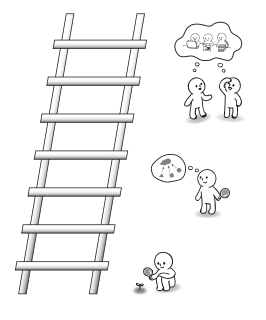Challenging Mission/OG
| Challenging Mission | |
| Contributors | Takashi Iba, Chikara Ichikawa, Mami Sakamoto, Tomohito Yamazaki |
|---|---|
| Last modification | May 15, 2017 |
| Source | Iba, Ichikawa, Sakamoto & Yamazaki (2011)[1] |
| Pattern formats | OPR Alexandrian |
| Usability | |
| Learning domain | |
| Stakeholders | |
You are about to design missions fit to the curriculum that you have already designed based on Discovery-Driven Expanding (Discovery-Driven Expanding). While you can find a lot of resources for conventional education for acquiring knowledge or skill of subjects, you realize that the resources for creative learning has not been developed enough. Thus, you find that you need to develop what you need in your class. What is most important is to design missions for creative learning.
There are many missions that tend to be unsuitable to creative learning because they either make learners too free and unfocused. If you make a mission based on the interests of students, it will become happy experience for them but hardly achieve epistemic change by learning. If you make a mission related to the subjects, it will be worthwhile to study but hardly educe autonomy and creativity of the learners.
Design missions that are effective for learning, attractive, and worthwhile to challenge, and at the appropriate levels of difficulty, increasing the difficulty level of missions gradually as follows: discovering the visible, discovering the invisible, and discovering how to discover. In first step, set missions for discovering something visible in a field. In second step, set missions for discovering something invisible hidden in the visible. In third step, set missions for discovering how to discover the solution for their mission.
For realizing creative learning, it is most important to organize missions that lead the learners to expand themselves gradually from their current levels. It seems be of the value to refer to the Learners Profile[2], and as a result missions can be designed for expanding the competencies of learners profile.
In addition, the missions need to contain the mysterious or interesting aspect in order to fascinating the learners. Also, the missions should be worthwhile to challenge because they are future-oriented and socially rooted. Finally, the difficulty levels of the missions need to be considered, where it is necessary that the missions look hard but they are possible to be completed.
Learners expand their capacity in stages, because it is necessary for them to nurture challenging mind gradually. In first step, learners become aware of the objects, behavior, and characteristics that are not focused before. In second step, learners become to think mechanisms and relationships hidden in visible things. In third step, learners become to develop their way to do things.
For instance, C. Ichikawa designs projects based on Challenging Mission at Tokyo Community School. In first and second grades, the class entitled “Leaves Wonder” offers students to collect leaves as many as possible in the park next to school. The mission is “Closely observe the visible form of leaves and analyze them from original point of view.” Students cannot finish their study just classifying leaves relying on a field guide, they have to discover some unique findings with reason. In third and forth grades, the class entitled “Water Purifying” gives students to mission; “Make the drinkable water”. Students make handmade water purifiers using plastic bottles, they purify rain water by use of it. In spite of getting clear water, they suspect they cannot drink it, because there is some invisible harmful thing in the water. They have to challenge discovering the method how to get rid of invisible things. In fifth and sixth grades, students do a mission entitled “space fantasy”. The mission is, “Create the Science-Fiction story where the characters jump out to space for expanding the possibility of human species” with the constraints that they need to make characters with a certain Learner Profile: Open-minded, Risk-takers and Principled. In the activity, learners start to think why human need to jump out to space, and then they discussed it. Students thought and understood social and environmental problems that human is facing deeper and deeper.
References
- ↑ Iba, T., Ichikawa, C., Sakamoto, M., & Yamazaki, T. (2011). Pedagogical patterns for creative learning. In Proceedings of the 18th Conference on Pattern Languages of Programs (PLoP 2011) (p. 28). ACM:New York.
- ↑ IB learner profile booklet. (2008). International Baccalaureate Organization.
